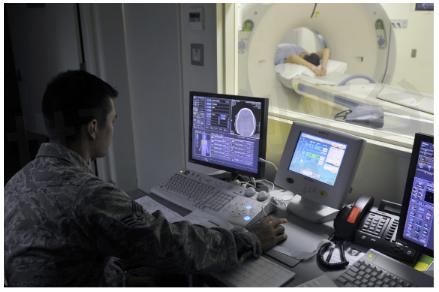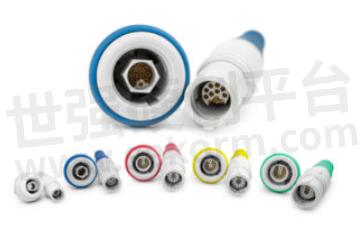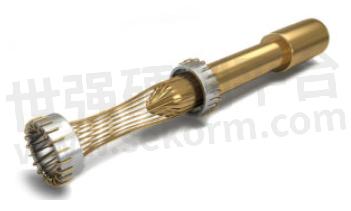Choosing the Right Interconnect Systems for Medical Device Designs

Medical devices, such as patient monitors, imaging systems, electrophysiology catheters, and other diagnostic and therapeutic systems, require dependable connectivity and accurate signal transmission. Equipment for the medical market must be designed to eliminate the potential for failure or loss of functionality. Interconnects are especially vulnerable because they are often employed in some of the most exposed areas of the system, with the potential for damage due to environmental factors or misuse. In the medical sphere, there are many factors to consider when selecting connectors to ensure maximum performance and reliability over the expected life of the device.

Proper Mating
The potential for mating connectors that don’t belong together is a safety risk in many medical applications. System developers can build safeguards by using an appropriate form of color-coding to provide a visual indication of a correct match between a plug and receptacle.
Color-coding systems often have to be decided when the connectors are purchased from the supplier because color is an unchangeable feature of the plastic housing. However, some connectors offer greater flexibility. For example, receptacle and plug color-coding can sometimes be attributed to the use of interchangeable and differently colored silicone rings and strain reliefs incorporated during the assembly process.
Incorrect mating can also be avoided by using keyed connectors, which incorporate a mechanism that physically prevents the plug and receptacle from being mated if they are an unmatched pair. Keyed connectors are available in several styles. Some use connectors that, while identical in every other respect, have fixed keys that are part of the connector body.
Others have customizable keying, which allows users to alter the keying of the connector by changing the position of an insert and can help lower the cost of inventory.
For example, a customizable keyed connector with six different positions affords developers the flexibility to alter the interconnect configuration as the system requirements evolve. In cases like this, mismating is prevented by a plastic barrier positioned between the plug and receptacle in such a way that only compatible connectors will be able to mate. This approach more effectively reduces the possibility of contact damage compared to connectors in which the contacts themselves provide the physical barrier to mismating.
Smiths Interconnect’s HyperGrip Series circular plastic connectors are color-coded, offer six different customizable keying options for quick and accurate connections, and meet medical industry requirements, including: finger-proofing to IEC 60601, IP67 sealing, UL94 V-O flammability ratings, and compatibilitywith most sterilization processes.

High Reliability
In medical applications, and especially those with a safety-critical function, extra care must be taken to ensure that plugs and receptacles remain reliably interconnected. One reliability safeguard is to ensure that the connector has been specified for a sufficiently high number of mating cycles. Some of the connectors used in patient monitoring equipment, for example, have to be mated and unmated many times a day over a lifetime of many years. Depending on the type of system, a connector may have to endure tens of thousands of mating cycles during its lifetime. So, typical high-quality medical, military, or industrial connectors, which are often specified to reliably perform for 500 to 1,000 mating cycles, are unsuitable for these types of applications.
Another reliability consideration is the degree of shock and vibration present in the usage environment. For instance, if the equipment has to be used in an ambulance, extra care should be taken to choose connectors that are specified for rough use.
Many connectors are designed for applications that involve rough handling, but medical connectors may also have to be handled with protective gloves that could be torn or damaged by sharp edges or awkward handling requirements. So, system developers should also be mindful of these reliability risks, as such damage could introduce an additional path for the spread of disease or infection.
Contact Design
The reliability of an interconnect — its ability to perform over a long lifetime or in demanding situations — is largely determined by its contact design. One point of vulnerability in contact designs is the cantilever-beam spring mechanism conventionally used in a connector’s construction. The high normal-force required by such interconnects not only results in high mating forces but also tends to cause the spring to wear out.
System developers can eliminate this weakness by using a connector with an alternative contact design. For example, a hyperboloid contact system with a wire basket construction provides a reliable contact that doesn’t require a high normal force. Connectors with hyperboloid contacts enable smooth insertion and low-force pin and socket mating that provides greatly increased longevity compared to many other contact technologies.
Connectors with hyperboloid contacts can generally withstand more than 20,000 mating cycles. Another benefit of hyperboloid wire basket contacts is the enhanced wiping action that cleans the contact mating surfaces as the pin pushes past the spring wires during mating.
High-density Hypertac® hyperboloid contacts from Smiths Interconnect offer superior signal integrity, high mating cycles, high current ratings, minimal contact resistance, immunity to shock and vibration, and self-cleaning capabilities

Connector Design
Medical connectors can also incorporate a variety of signal, power, high-frequency coax, and high-data-rate fiber-optic contacts to meet the specific needs of an array of medical device developers. For example, high-density signal requirements can be addressed with spring probe contacts to avoid having to increase the size of the connector and several different contact technologies can be incorporated within a single hybrid connector to achieve the functionality of two or more different interconnects without the additional cost and board space requirements of multiple connectors.
In applications where one half of a connector forms part of a disposable element, such as an electronic catheter, but the other half must reliably perform for many thousands of mating cycles, it is tempting for developers to attempt to engineer the disposable half themselves to reduce costs. However, this practice should generally be avoided, as it’s easy to underestimate the engineering effort required to design high-reliability connectors. Ensuring that a connector supplier has designed both the plug and receptacle for a given application can proactively prevent potential electrical problems and equipment damage.
Medical appliances are increasingly incorporating plug-and-play functionality to simplify the process of connecting different pieces of equipment. Designs that support this capability normally include additional electronics or intelligence, like a chip that communicates with the host system to provide details about the identity or status of the connected device.
These components may be located in the equipment itself or, for electrical reasons, within the connector housing. System developers can choose to implement this additional functionality themselves, especially if it’s located within the equipment. However, if it’s to be included in a connector, it’s worthwhile to have the connector manufacturer add said functionality in during the design process, as adding it post-production could compromise the connector’s design and significantly diminish its performance and reliability.
Operating Environment
It is often important to ensure that connectors are designed to withstand exposure to some of the cleaning and sterilization methods used in certain medical environments, which range from mild soap solutions to alcohol, ethylene oxide gas, gamma radiation, and high-temperature steam autoclaving, which is widely used to sterilize cables, tools, and other accessories.
Additionally, since magnetic components positioned near the RF coil in MRI scanners can cast shadows on the generated images, they have been eliminated in more recent and more powerful MRI system designs. Non-magnetic connectors are now increasingly available to support this requirement. Some manufacturers have even effectively addressed the performance requirements of MRI scanners with non-magnetic variants of high-reliability connectors, incorporating them into fully non-magnetic cable assemblies and interconnect subsystems.
Summary
Given the demanding requirements of many medical applications, it’s important to consider to the many elements of connector design early in the development stage to ensure effective selections. Connectors are frequently considered after much of the design has taken shape, but this can be especially problematic for medical designs — for example, if the connectors used for the prototype don’t support the requisite number of mating cycles or if the connectors are vulnerable to damage from medical cleaning protocols. Although connector suppliers can engineer custom solutions if such problems arise, designers can avoid this added and extraneous expense by carefully considering interconnect requirements early in the design process.
Smiths Interconnect is a leading provider of technically differentiated electronic components, subsystems, microwave and radio frequency products that connect, protect, and control critical applications in the medical, commercial aviation, defense, space, semiconductor test, wireless telecommunications, and industrial markets.
- +1 Like
- Add to Favorites
Recommend
- Smiths Interconnect announced Hypergrip® Connector Series for the Medical Market Segment
- Smiths Interconnect New Hypertac Green Connect Contact Technology is Designed to Reduce Power Loss
- Smiths Interconnect Hypertac Green Connect: A Game-changer in the Battery Electric Vehicles Industry
- Smiths Interconnect Expands Its Product Offering for Medical Applications
- Smiths Interconnect Offered Isolators to Support NASA’s Europa Clipper Mission to Explore Jupiter’s Moon
- How Smiths Interconnect Keeps The Medical World Connected
- Smiths Interconnect’s DaVinci 112 High-Speed Test Socket Wins Best Test Measurement Award at the 2024 Global Electronics Achievement Awards
- Smiths Interconnect Completes Product Offering for Disposable Healthcare Devices
This document is provided by Sekorm Platform for VIP exclusive service. The copyright is owned by Sekorm. Without authorization, any medias, websites or individual are not allowed to reprint. When authorizing the reprint, the link of www.sekorm.com must be indicated.





























































































































































































































































































































































































































































































































































































































































































































































































































































































